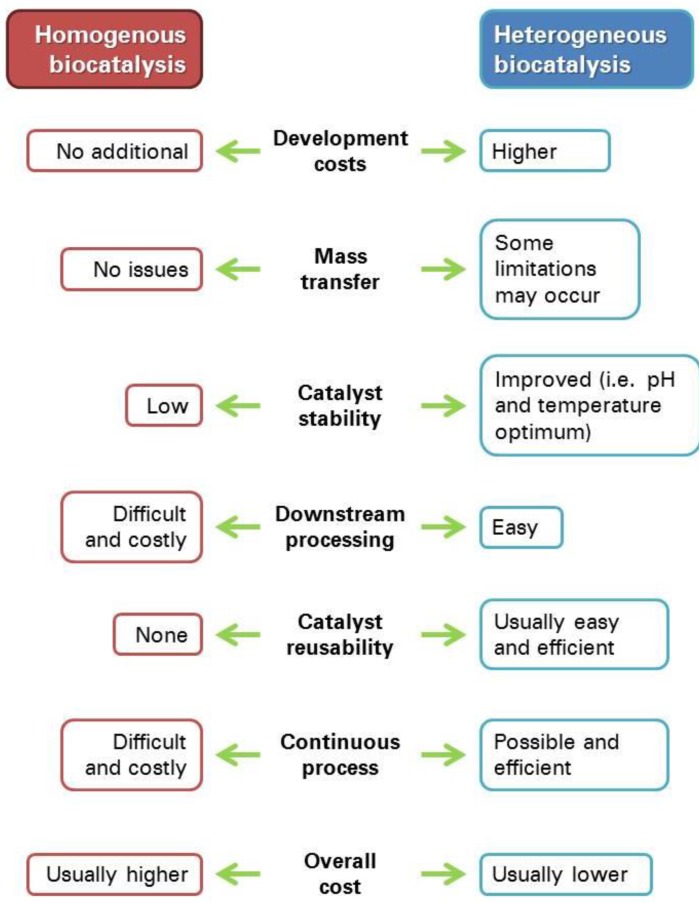CD Biosynsis is a leading expert that has been dedicated to providing researchers with a wide range of enzyme design services for a long time. Particularly, we focus on enzyme immobilization design strategies to improve enzyme stability, reusability, and ease of isolation. By coating or encapsulating enzymes on solid supports or substrates, we are able to develop powerful biocatalysts for a wide range of applications including biocatalysis, biosensing and bioremediation.
Overview
Through enzyme immobilization techniques, enzymes can be immobilized on solid supports or self-assembled into insoluble particles, which can significantly improve the stability, reusability, and applicability properties of enzymes in changing environments. Enzyme immobilization on nanoparticles is a powerful strategy in biocatalysis. Nanoparticles are ideal carriers for immobilizing enzymes due to their multiple advantages compared to conventional free enzyme systems, such as large surface area, stability, and potential for enhanced mass transfer.
 Fig. 1 Comparison of main properties of enzymatic industrial processes, both in homogeneous and heterogeneous form. (Zucca P., et al., 2016)
Fig. 1 Comparison of main properties of enzymatic industrial processes, both in homogeneous and heterogeneous form. (Zucca P., et al., 2016)
Our Services
Due to the high specificity and efficiency, enzymes play important roles in catalyzing reactions for various industrial processes. However, a major challenge in utilizing enzymes in industrial processes is their limited stability and recoverability in solution. EnzymoGeniusTM platform aims to overcome the difficulties of enzyme applications in industry through coating enzymes to solid supports or nanoparticles.
We can use the following nanoparticles for enzyme immobilization to enhance enzyme biocatalysis.
- Metal Nanoparticles, such as gold, silver, and magnetic nanoparticles, are commonly used due to their unique properties and ease of functionalization.
- Metal Oxide Nanoparticles, such as titanium dioxide (TiO2), silica dioxide (SiO2), and ferroferric oxide (Fe3O4) nanoparticles, are popular choices for enzyme immobilization.
- Polymeric Nanoparticles, such as chitosan and poly lactic-co-glycolic acid (PLGA), also can be used to encapsulate enzymes to improve enzyme stability.
- Carbon-Based Nanoparticles, such as graphene and carbon nanotubes, are good nanomaterials for enzyme immobilization due to their excellent mechanical strength and electrical conductivity.
Advantages of Nanoparticles for Enzyme Immobilization
- Improve Stability
Enzyme immobilization on nanoparticles can improve enzyme stability and prevent denaturation and degradation.
- Enhance Mass Transfer
Nanoparticles can enhance the mass transfer of substrates and products, so as to improve the overall reaction efficiency.
- Large Surface Area
Nanoparticles have a large surface area to volume ratio, which can immobilize a large amount of enzyme.
- Reusability
The enzyme-nanoparticle system can be easily recycled and reused, thereby reducing costs.
- Tunable Properties
Nanoparticles can be modified to have specific properties such as magnetic responsiveness or controlled release properties.
Applications for Enzyme Immobilization on Nanoparticles
- Drug Synthesis
Enzyme-nanoparticle systems can be used to synthesize drug intermediates and active compounds.
- Biofuel Production
Nanoparticles can facilitate enzymatic reactions in the production of biofuels.
- Food Industry
Enzymes immobilized on nanoparticles can be used in food processing to improve the efficiency of certain reactions.
- Environmental Remediation
In wastewater treatment, enzyme-nanoparticle systems can be used to degrade pollutants.
CD Biosynsis provides fast and efficient enzyme research services through our EnzymoGeniusTM platform to enhance enzyme stability and availability for worldwide customers. If you are interested in our services and need more detailed information about enzyme immobilization, please don't hesitate to contact us.
Reference
- Zucca, P.; et al. Agarose and Its Derivatives as Supports for Enzyme Immobilization. Molecules. 2016, 21(11):1577.

































 Fig. 1 Comparison of main properties of enzymatic industrial processes, both in homogeneous and heterogeneous form. (Zucca P., et al., 2016)
Fig. 1 Comparison of main properties of enzymatic industrial processes, both in homogeneous and heterogeneous form. (Zucca P., et al., 2016)